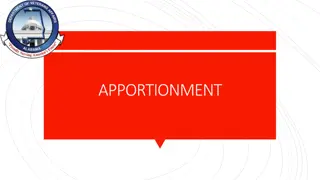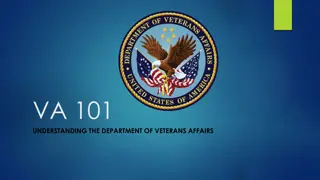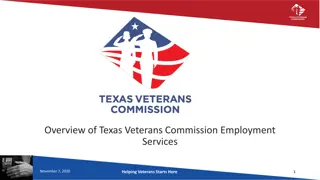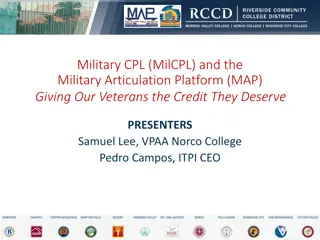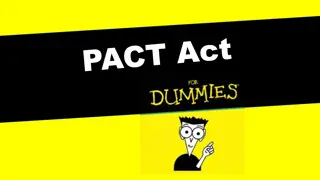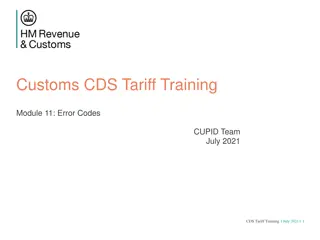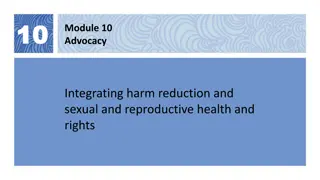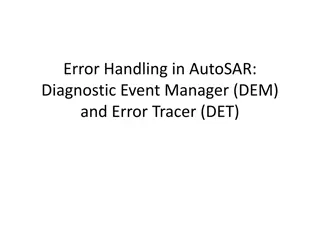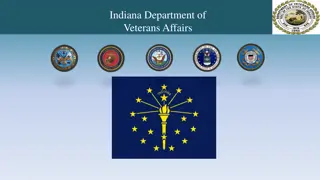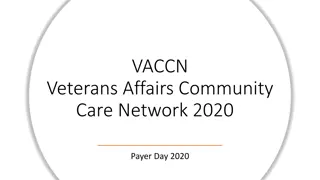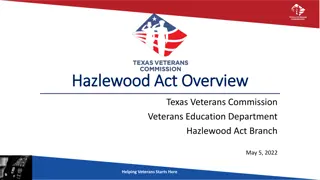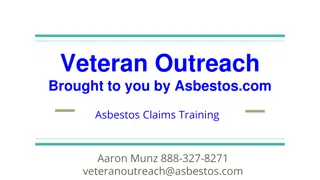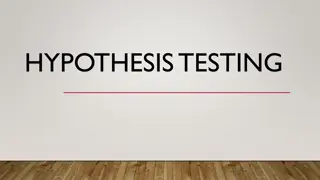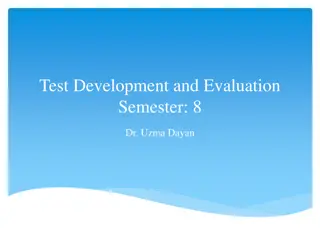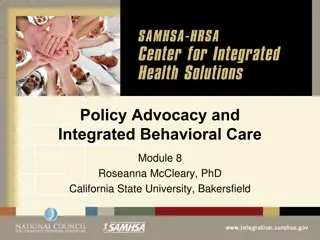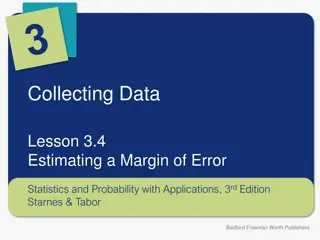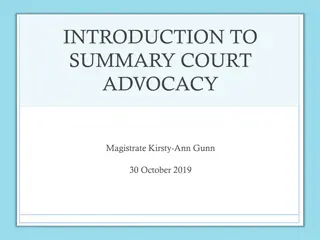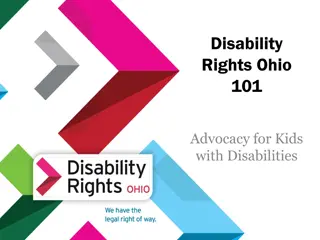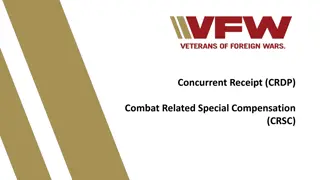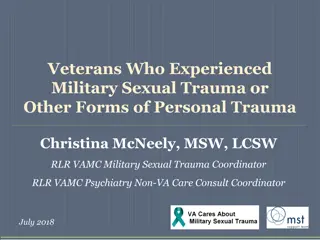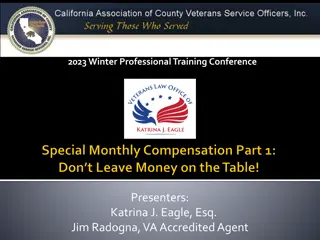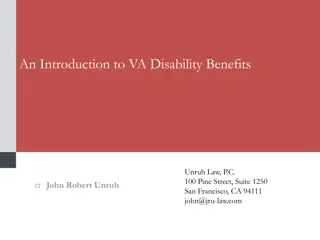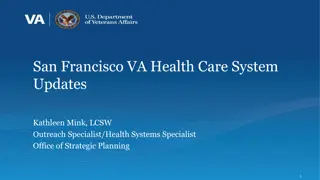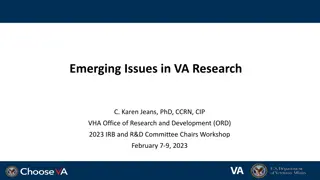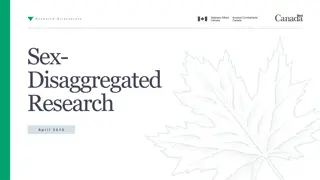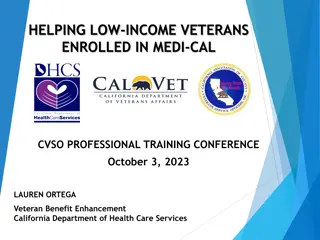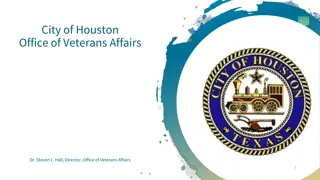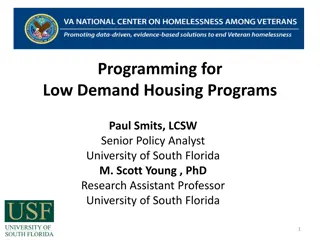Understanding Clear and Unmistakable Error in Veterans Advocacy
Clear and Unmistakable Error (CUE) is a complex and often misunderstood concept in Veterans Advocacy. Winning a CUE claim can be extremely challenging, and it requires a thorough understanding of the criteria involved. This article delves into the nuances of CUE, providing insights on how to identify, evaluate, and proceed with such claims effectively.
Download Presentation

Please find below an Image/Link to download the presentation.
The content on the website is provided AS IS for your information and personal use only. It may not be sold, licensed, or shared on other websites without obtaining consent from the author. Download presentation by click this link. If you encounter any issues during the download, it is possible that the publisher has removed the file from their server.
E N D
Presentation Transcript
Fall 2021 Professional Training Conference Presenters: Katrina J. Eagle, Esq. Jim Radogna, VA Accredited Agent
Clear and Unmistakable Error is perhaps the most overused term and misunderstood concept in Veterans Advocacy. We constantly see references to CUE in c-files: Statements in Support of Claim, Supplemental Claims, HLRs, NODs, briefs, etc. We field questions during CVSO trainings: VA denied my Veteran s claim and it was a really bad decision, so should I do a HLR, SC or just file a CUE? We have regular conversations with potential clients: I was reading about that CUE thing on the internet, and I m convinced my claim is one of those VA denied the claim in 1985 but granted it in 2016 on the same facts so it must have been CUE in 1985, right? Maybe it should be called Clear and Unmistakable Enigma?
Its extremely difficult to win on CUE either before the RO, BVA, the Veterans Court, or the CAFC. The finality of VA decisions is revered by most judges. The general feeling is that claimants have the opportunity to take advantage of a very generous appeal process. No matter how badly VA screwed up, the error may not be bad enough to rise to the level of CUE. CUE claims are definitely winnable, but they ll likely be the toughest you ll ever litigate. Throwing CUE allegations against the wall and hoping they ll stick is probably not a winning strategy. Knowledge Is Power, so let s learn all we can about CUE
First, ask yourself some questions: Is the error a matter of opinion or indefensible? If the error wasn t made would a different outcome have been guaranteed? Did the error only become apparent after new evidence became available? Have the regulations changed since the decision was made? Did VA s interpretation of the regulations comport with accepted guidelines at the time of the challenged decision? Was there evidence both for and against the claim? Was the error based on a duty to assist failure on VA s part? Does Benefit of the Doubt potentially come into play? Still feel like you have a CUE? What do you do next?
CUEs are not actually claims and they are not appeals. They are a request for revision of a FINAL VA decision based on clear and unmistakable error. A CUE request regarding a prior FINAL decision is NOT the same thing as a Supplemental Claim. A CUE request is seeking to revise the prior FINAL decision to conform to the true state of the facts or the law that existed at the time of the original adjudication. When a CUE claim is successful, the effective date assigned will be that of the underlying claim that the challenged decision denied. A retrospective analysis for ratings may be necessary. Once a CUE claim is granted, new evidence can be added to the record by the claimant to ensure that the highest ratings possible are assigned. VA must provide the appellant with all appropriate assistance in developing evidence on the rating question. Hines v. Principi, 18 Vet. App. 227, 242 (2004) CUEs are decided in the same manner as regular RO or BVA decisions; thus, a successful CUE SC decision with an improper assigned rating can be appealed.
38 CFR 3.160(d) Finally adjudicated claim. A claim that is adjudicated by the Department of Veterans Affairs as either allowed or disallowed is considered finally adjudicated when: (1) For legacy claims not subject to the modernized review system, whichever of the following occurs first: (i) The expiration of the period in which to file a Notice of Disagreement, pursuant to the provisions of 19.52(a) or 20.502(a) of this chapter, as applicable; or (ii) Disposition on appellate review. (2) For claims under the modernized review system, the expiration of the period in which to file a review option available under 3.2500 or disposition on judicial review where no such review option is available.
Primary CUE Statutes and Regulations: VARO: 38 USC 5109A - Revision of decisions on grounds of clear and unmistakable error 38 CFR 3.105 - Revision of decisions Board: 38 USC 7111 - Revision of decisions on grounds of clear and unmistakable error 38 CFR 20.1403 - What constitutes clear and unmistakable error; what does not
Error in final decisions. Decisions are final when the underlying claim is finally adjudicated as provided in 3.160(d). Final decisions will be accepted by VA as correct with respect to the evidentiary record and the law that existed at the time of the decision, in the absence of clear and unmistakable error. At any time after a decision is final, the claimant may request, or VA may initiate, review of the decision to determine if there was a clear and unmistakable error in the decision. Where evidence establishes such error, the prior decision will be reversed or amended. 38 CFR 3.105(a)(1)
(i) Definition of clear and unmistakable error. A clear and unmistakable error is a very specific and rare kind of error. It is the kind of error, of fact or of law, that when called to the attention of later reviewers compels the conclusion, to which reasonable minds could not differ, that the result would have been manifestly different but for the error. If it is not absolutely clear that a different result would have ensued, the error complained of cannot be clear and unmistakable. Generally, either the correct facts, as they were known at the time, were not before VA, or the statutory and regulatory provisions extant at the time were incorrectly applied. 38 CFR 3.105(a)(1)(i)
(iii) Record to be reviewed. Review for clear and unmistakable error in a prior FINAL decision of an agency of original jurisdiction must be based on the evidentiary record and the law that existed when that decision was made. The duty to assist in 3.159 does not apply to requests for revision based on clear and unmistakable error. (iv) Change in interpretation. Clear and unmistakable error does not include the otherwise correct application of a statute or regulation where, subsequent to the decision being challenged, there has been a change in the interpretation of the statute or regulation. (v) Limitation on Applicability. Decisions of an agency of original jurisdiction on issues that have been decided on appeal by the Board or a court of competent jurisdiction are not subject to revision under this subsection. 38 CFR 3.105(a)(1)(iii),(iv),(v)
For VA decisions issued after July 21, 1992, the record that existed on the date of the decision includes records that were within the Secretary s control and that could reasonably be expected to be a part of the record. For Board decisions, this includes relevant documents possessed by VA not later than 90 days before such record was transferred to the Board for review in reaching that decision, provided that the documents could reasonably be expected to be part of the record. This means that for decisions issued after July 21, 1992, VA medical records or other adjudication records are considered part of the claims file, even if they were not actually in the claims file on the date of the decision.
Either the correct facts, as they were known at the time, were not before the adjudicator, (e.g., the adjudicator overlooked them) or the statutory or regulatory provisions extant at the time were incorrectly applied, The error must be the sort which, had it not been made, would have manifestly changed the outcome at the time it was made, and, The determination must be based on the record and the law that existed at the time of the prior adjudication in question. M21-1 III.iv.2.B.4.a.
A CUE will fall into one or more of the following categories: The decision maker failed to apply or incorrectly applied the appropriate laws or regulations. (Note: These legal errors commonly involve pre-reduction due process or the failure to apply a statutory or regulatory presumption.) The decision maker overlooked material facts of record, or, The decision maker failed to follow a procedural directive that involved a substantive rule (a rule that regulates a right). A duty to assist deficiency such as an insufficient examination cannot form a basis for CUE since such deficiency creates only an incomplete rather than an incorrect record. Exception: A failure to consider VA medical records, which were in VA s constructive possession at the time of the prior decision, may constitute a CUE, if such failure affected the outcome of the claim. M21-1 III.iv.2.B.4.c
When submitting a CUE claim in a rating decision there is a pleading requirement. The claimant must raise the issue of CUE to the VA with specificity as to when and how the error occurred. It is not enough for a claimant to state simply that the RO was wrong in its prior decision; a detailed argument identifying the error is essential to prevail on a theory of CUE. If a claimant fails to meet the pleading requirements for CUE, the request will be dismissed without prejudice. An unfavorable RO determination on a CUE request can be appealed to the BVA. A claimant may not request revision of an earlier, final RO decision on the basis of CUE if the earlier RO decision was subsumed by a subsequent BVA denial (i.e., was appealed to the BVA or otherwise addressed in a later BVA decision), but in that case a CUE motion may be filed directly to the Board attacking the subsequent BVA decision.
M-21 III.iv.2.B.4.d. Considering Requests for Revision Based onCUE: Although there is no specific claim form required to request a revision based on CUE, the request must be submitted in writing and signed by either the claimant or his/her authorized representative.* In a valid claim of CUE, the claimant must set forth clearly and specifically the alleged error, or errors, of fact or law in the prior decision, the legal or factual basis for such allegations, and why the result would have been manifestly different but for the alleged error. * NVLSP recommends filing Form 21-526EZ along with argument in support of CUE claim. We ve also seen CUE claimed in HLRs.
M-21 III.iv.2.B.4.d. Considering Requests for Revision Based on CUE (continued): A Claimant is not entitled to request CUE again once there has been a final decision denying CUE on the same basis. Keep in mind, in a CUE request at the RO level, you may be able to get another bite at the apple because you may be able to file additional CUEs if you allege multiple errors were made.
Although clearly and unmistakably erroneous is the standard in severance cases, the inquiry does not stop with the information available to the VA at the time of the decision that initially granted service connection. For example, a post-decisional change in diagnosis may be accepted as a basis for severance under certain circumstances. Allen v. Nicholson, 21 Vet. App. 54, 59 (2007); Stallworth v. Nicholson, 20 Vet. App. 482, 488 (2006). If a CUE is alleged by VA, it can revise a decision based on CUE even during an open appeal period. Young v. Wilkie, 31 Vet.App. 51 (2019)( it is far more efficient and beneficial to claimants to allow VA to correct obvious errors at the time of the identification of the error than to force it to wait until a claim is fully adjudicated and then pursue overpayments in the form of recoupment. )
To seek revision of a prior BVA decision based on CUE, the claimant must file a motion with the BVA. The motion must clearly and specifically set forth the alleged clear and unmistakable error, or errors, of fact or law in the Board decision, the legal or factual basis for such allegations, and why the result would have been manifestly different but for the alleged error. (This is especially true for attorneys.) If the applicable decision involved more than one issue on appeal, the motion must identify the specific issues to which the motion pertains. Motions that fail to comply with these procedural requirements will be dismissed without prejudice to refiling under this subpart. 38 C.F.R. 20.1404 If a CUE motion is dismissed by the Board on the ground that the CUE motion lacks sufficient clarity or specificity, the claimant has the right to challenge the Board s decision by appeal to the CAVC. Canady v. Nicholson, 20 Vet. App 393 (2006). AOD can be requested for serious illness or extreme financial hardship. The BVA s final decision on CUE may be appealed to CAVC.
Unlike the RO, BVA may only consider a CUE allegation once. An appellant may not bring more than one clear and unmistakable error challenge to an issue in a final Board decision. As such, claimant must state all possible bases for challenging a BVA denial of a claim based on CUE. But, if the BVA denial of the first CUE motion was for procedural reasons, then the claimant may submit a second CUE motion challenging the same decision. If a CUE motion related to a BVA decision containing more than one claim for benefits is denied, then the claimant is free to submit a second CUE motion on a claim not covered by the first CUE motion. Issues in a BVA decision that were reviewed and decided by the Court cannot thereafter be challenged through motions alleging CUE. A CUE motion can still be filed with respect to issues that were appealed to the Court but then abandoned prior to a Court decision.
38 CFR 20.1411 states that the following rules that normally apply to other VA claims do NOT apply to CUE claims: (a) The benefit of the doubt rule of 38 U.S.C. 5107(b) does not apply to the Board's decision, on a motion under this subpart, as to whether there was clear and unmistakable error in a prior Board decision. (b) For legacy appeals as defined in 19.2 of this chapter, a motion under this subpart is not a claim subject to reopening under 38 U.S.C. 5108 (relating to reopening claims on the grounds of new and material evidence). (c) A motion under this subpart is not an application for benefits subject to any duty associated with 38 U.S.C. 5103(a) (relating to applications for benefits). (d) A motion under this subpart is not a claim for benefits subject to the requirements and duties associated with 38 U.S.C. 5103A (imposing a duty to assist). NOTE: The Board, for good cause, may grant a request for a hearing for the purpose of argument (no testimony or other evidence). 38 C.F.R. 20.1405(c).
The Russell 3-pronged test for determining CUE: 1. Either the correct facts, as they were known at the time, were not before the adjudicator (i.e., more than a simple disagreement as to how the facts were weighed or evaluated) or the statutory or regulatory provisions extant at the time were incorrectly applied, 2. The error must be "undebatable" and of the sort "which, had it not been made, would have manifestly changed the outcome at the time it was made," and, 3. A determination that there was CUE must be based on the record and law that existed at the time of the prior adjudication in question. Russell v. Principi, 3 Vet. App. 310, 313-14 (1992)
It must be remembered that there is a presumption of validity to otherwise final decisions, and that where such decisions are collaterally attacked, and a clear and unmistakable error claim is undoubtedly a collateral attack, the presumption is even stronger. Similarly, the Court has rejected as being too broad general and unspecified allegations of error based on the failure to follow regulations, failure to give due process, failure to accord benefit of the doubt, failure of duty to assist, and any other general, non-specific claim of error. Fugo v. Brown, 6 Vet. App. 40, 43-44 (1993)
Whether it is reasonable to conclude that the outcome would have been different is not the standard that must be met for a motion alleging [CUE] to succeed. The governing law requires that the error be 'undebatable' and that the commission of the alleged error must have 'manifestly changed the outcome' of the decision. King v. Shinseki, 26 Vet.App. 433, 442 (2014).
VA wrongly labeled spondylolysis as a non-compensable defect. BVA erroneously failed to consider the evidence submitted by appellant. RO failed to properly consider the presumptions of soundness and aggravation. The Board properly determined that the appellant's ulcer condition preexisted service but erred in its determination regarding aggravation. BVA and CAVC erred in requiring medical evidence demonstrating an etiological link given that Veteran s condition diagnosed in service was chronic. VA failed to rebut the presumption of soundness with clear and unmistakable evidence. Veteran was rated at 40% when rating schedule schedular minimum was 60%. VA failed to properly follow the Schedule for Rating Disabilities.
BVA's failure to apply correctly the allocation of burden regarding a showing of material improvement under 38 C.F.R. 3.343(a) constitutes CUE. BVA ignored overwhelming evidence, thus the Board's decision was arbitrary. RO did not have "clear and convincing evidence" with which to terminate IU. VA is required to give a sympathetic reading to the veteran's filings by determining all potential claims raised by the evidence, applying all relevant laws and regulations. VA continually ignored and disregarded medical opinions. BVA s failure to provide a written statement of the Board's findings and conclusions, and the reasons or bases for those findings and conclusions. BVA abused its discretionary authority by deciding that 38 C.F.R. 3.344 did not apply to the facts of the case. BVA s determination that there was no clear and unmistakable error was not accompanied by the explanatory statement of the reasons or bases.
Changed diagnosis. A new medical diagnosis that corrects an earlier diagnosis considered in a Board decision. Duty to assist. The Secretary's failure to fulfill the duty to assist. Evaluation of evidence. A disagreement as to how the facts were weighed or evaluated. When there is evidence both pro and con on the issue it is impossible for the appellant to succeed in showing that the result would have been manifestly different. Simmons v. West, 13 Vet. App. at 505. Change in interpretation CUE does not include the otherwise correct application of a statute or regulation where, subsequent to the decision challenged, there has been a change in the interpretation of the statute or regulation. Harmless error. It must be absolutely clear that a different result would have ensued but for the error. Benefit of the doubt is not applicable to a CUE determination. The benefit of the doubt rule of 38 U.S.C. 5107( b) could never be applicable; an error either undebatably exists or there was no error within the meaning of 3.105(a). Russell v. Principi, 3 Vet. App. 310.
VA erred in not considering evidence, but the error was not the sort which, had it not been made, would have manifestly changed the outcome. Broad-brush allegations of failure to follow the regulations or failure to give due process, or any other general, non-specific claim of error can never rise to the stringent definition of CUE. The Board correctly identified facts as disqualifying the appellant's rating from protection under 38 C.F.R. 3.344. To prove the existence of CUE as set forth in 3.105(a), the claimant must show that an outcome-determinative error occurred. VA's case processing at issue here was arguably less than perfect in all of the various steps of its evaluation and treatment of appellant s condition. None of these miscues, however, rise to the level of CUE. A breach of the duty to assist cannot constitute CUE. If additional evidence is needed to discern an error in the prior decision, the decision itself was not made in error so as to contain CUE.
An incomplete record, factually correct in all other respects, is not clearly and unmistakably erroneous. Improperly weighed and evaluated evidence can never rise to the stringent definition of CUE. A correct facts before the adjudicator inquiry does not mean the correct facts as they are now known. An appellant may rephrase and provide additional argument and support for the same basic CUE argument. However, an entirely different argument is prohibited. An appellant has only one opportunity to raise allegations of CUE for each claim decided in a Board decision. The VA does not commit CUE when it faithfully applies a regulation as it existed at the time of decision, even if that regulation is later revised or invalidated. Multiple CUE challenges of a BVA decision are prohibited even if each challenge is based on a different CUE theory.
38 CFR 3.156 (b) Unadjudicated legacy claim new and material evidence received within appeal period but not adjudicated. 38 CFR 3.156(c) - If VA receives or associates with the claims file relevant official service department records that existed and had not been associated with the claims file when VA first decided the claim, VA will reconsider the claim.
Show us the goods! i.e., a current grant and a prior denial on the exact same issue and the exact same evidence. Download the eFolder and review the entire file. Carefully review the procedural history. Carefully review ALL evidence before adjudicator at the time of challenged decision. Research VA law and regulation extant at time of challenged decision. Test the viability of the CUE allegation by asking key questions (see slide 4 be objective!). Deliberate between ourselves to determine if the error is debatable. If we can honestly debate it, it s likely not CUE.
Feel free to contact us about questions from this training or ANYTIME you have a question about a claim: CACVSO@eagleveteranslaw.com



